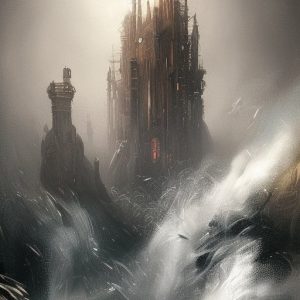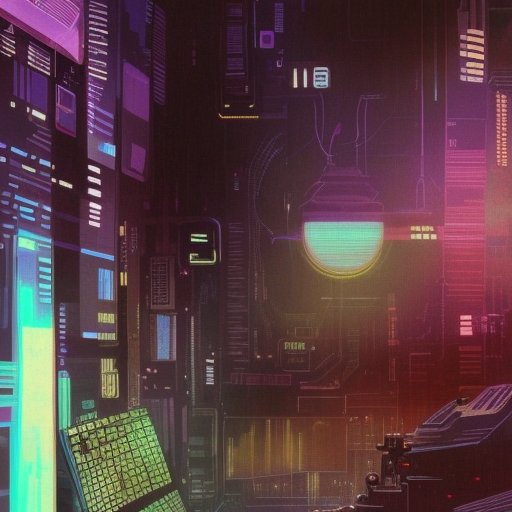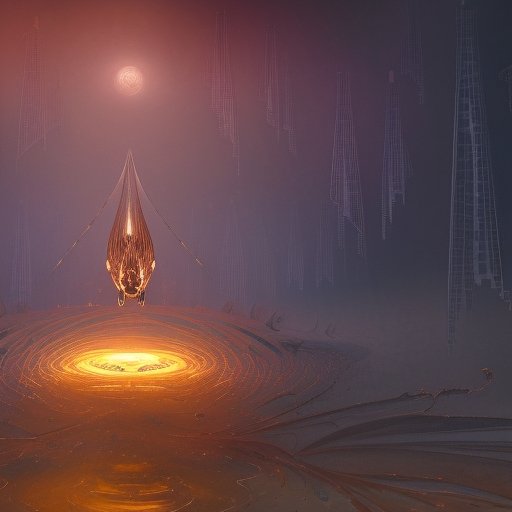
In the age of technology, the heart of music beats on. The extraordinary developments in fields such as AI, 3D printing, and teleportation have revolutionized the production of music. Yet, the evolution of sound is far from over, and the ethics of music ownership remains a great challenge. To understand the power of music, we must explore its intersections with science and other fields. As we venture further into deep space and encounter the unknown, music will follow us, inspiring heroism and unity. Join us on a journey to learn about the future of music, its evolution, and its significance in a rapidly changing world.
I. Introduction
In the age of technology, music remains the beating heart of humanity. As we colonize new frontiers, we carry the sounds of our history and culture with us, inspiring heroism and unity. But the evolution of sound has undergone remarkable transformations with innovations such as AI, 3D printing, and teleportation. The production of music is no longer confined to the minds and instruments of a few but is open to the world.

The striking advancements made in the field have paved the way for a new era of music, from the chaotic energy of dubstep to the grand majesty of orchestral pieces. The smooth jazz of steam punk glides alongside the melodious tunes of catbus and anime soundtracks, showcasing the versatility of human creativity. Yet beneath the sonic marvels that surround us, there lingers a growing concern. The issues of music ownership and cultural history continue to haunt the industry, with consumerism driving the narrative.
To understand music’s place in tomorrow’s world, we must explore the cutting-edge developments in science and technology driving the production of music. Beyond the techniques and practices that have brought us this far, lies a deep intersection between music and the cosmos, touching upon phenomena such as gravity control, string theory, and quantum mechanics. These subjects, often relegated to the realm of science fiction, are providing new pathways for music to thrive and evolve.
Therefore, this article seeks to explore music’s future in the age of technology. As we journey ever further into deep space and encounter vast unknowns, music will continue to follow us. Our journey will take us through the boisterous raves of faraway planets to the quiet somber towns of the Milky Way. We will explore the impact of music, celebrate its heroism, and understand its vital importance in a rapidly changing world. Join us as we venture towards the infinite horizon of music and its untold wonders.
II. The Future of Music Production
The future of music is now, shaped by the fantastic advancements in AI, 3D printing, and teleportation. Singers and composers are no longer slave to time, space, or even physical limitations. With the aid of AI, musicians can create complex melodies and harmonies with ease. The music industry has been revolutionized by 3D printing technology, with instruments and accessories being printed at lightning speed. Even teleportation technology has transformed the way music is created and performed, enabling new forms of collaboration beyond the barriers of distance.

Indeed, AI in music has transformed our understanding of how music is composed, recorded, and performed. AI-assisted music modeling enables musicians to produce works at a fraction of the time that it would have taken previously. Coupled with deep learning algorithms, AI has taken music composition to a new level. In addition, the music community is exploring the use of AI for sound generation, instrument design, and even performance assistance.
At the same time, 3D printing offers an entirely new level of integration in music production. Historically, instruments were complex to create and expensive, but 3D printing has brought the process into the reach of every musician. Musicians are crafting custom instruments, parts, and accessories tailored to their specific needs or desires. The ability to print a three-dimensional object using multiple materials, including metal, has opened up new design possibilities for instruments.
Finally, teleportation technology has also revolutionized the way music is produced and performed. It enables musicians to collaborate remotely, record live sessions from multiple locations, and even allows for a virtual reality concert experience. These advances have allowed for new forms of creativity and collaboration in music production.
The future of music production is bright as we explore the many innovations that drive the sound’s evolution. Coupling AI, 3D printing, and teleportation technology has enabled musicians to break free from some of the traditional constraints on their creativity. These breakthroughs not only offer new opportunities for musical expression but also challenge us to reimagine how music is created and experienced.
III. The Evolution of Sound
The evolution of sound is a captivating glimpse into the diversity of human creativity. From the intricate tunes of steam punk to the thudding beats of dubstep, music has undergone significant transformations over the last few decades. The soundscapes that we create today are a result of a collision between inspiration and technological innovation. The experimentation with new audio engineering techniques, using everything from synthesizers to software and hardware systems, has opened up a new realm for musicians to cultivate their creative talent.

In the world of music, fashion is equally as important as melody. The role of music extends beyond mere entertainment, shaping various subcultures that celebrate individualism and innovation. The sounds of the underground permeate the mainstream, stimulating new sonic explorations and redefining music as an adventurous experience.
The years have been generous to the music industry, unearthing new genres and reimagining the way we experience sound altogether. The early 80s gave birth to the fast-paced genre of heavy metal, while the 90s saw the rise of grunge and the iconic post-punk outfits that gave voice to an angsty generation. Throughout this era, electronic music became a staple of the industry, embracing the atomic power of synthesizers and opening the door for DJs to make their mark.
As technology continued to evolve at a breakneck pace, so did the music that catered to it. The turn of the millennium saw the emergence of dubstep, a subgenre of electronic music that incorporates complex and hard-hitting beats into its mixes. Yet perhaps the most significant development in music in recent times has been the reemergence of vinyls, as people dusted off their old turntables and embraced the vintage charm of an analog sound.
The future of music promises to be as varied as the past, with new genres and sounds promising to delight our senses. As we explore innovative tools and techniques in the production and distribution of music, the question remains open. What new form of music will emerge to shape the world of sound anew? Only time will tell.
IV. The Ethics of Music Ownership
The power of music to bring us together is undeniable. But amidst the song and celebration, a darker tune haunts the industry. The issue of music ownership and cultural history remains a critical point of concern. While some argue that music belongs to everyone and should be freely accessible to all, others argue that art represents a person’s unique expression and should be protected under property laws.

Consumerism, too, plays a significant role. In a world where music has become a commodity and is viewed as a source of profit, cultural heritage can be easily overlooked. Music, which is often the voice of the marginalized and oppressed, can be appropriated by those in power, erasing the authenticity and meaning of the art form. The devaluation of music as a product has led to an erosion of the creative process, with mainstream music homogenizing into easily marketable tunes.
As we venture into a future shaped by technology, we must address these concerns. Blockchain and other technologies can be used to secure artists’ rights while ensuring that music is not used to perpetuate oppression. Cultural heritage must be preserved and protected through the establishment of cultural centers and incentives for traditional and folk musicians to pursue their art. The value of music must be restored so that the creative process is driven by artistic merit rather than financial gain.
V. The Intersection of Music and Science
As music evolves in the age of technology, its intersection with science grows more profound. In particular, the seemingly disparate fields of music and physics have come together to offer exciting new possibilities for the sounds of the future. The exploration of Non-Newtonian Mechanics has paved the way for new breakthroughs in sound design. The mechanics of fluids have provided inspiration for the creation of new instruments and sounds, leading to more complex and dynamic soundscapes that challenge traditional genres.

At the forefront of this revolution lies the realm of Quantum Physics. The peculiarities of the quantum world have opened new realms of possibilities and dared musicians to dream bigger. Quantum entanglement has allowed for instantaneous communication across great distances, leading to the creation of collaborative compositions across galaxies. Meanwhile, the concept of superposition has allowed for the creation of sounds that defy all classifications and cannot be replicated. Finally, the controversial theory of parallel universes has challenged musicians to imagine the sound of an alternate reality.
But for all the excitement these breakthroughs bring, there remain serious ethical concerns. As we delve deeper into the quantum world, we risk creating a fundamental rift between what we consider real and artificial. The creation of artificial sounds and the manipulation of musical elements could have far-reaching implications, both positive and negative. It will take careful consideration and open debate to ensure that music retains its humanity in a world dominated by machines.
Nevertheless, the potential rewards of this intersection cannot be ignored. The exploration of non-Newtonian mechanics and quantum physics promises a future where music is more intricate, more dynamic, and more accessible. We live in a time of boundless creativity and imagination, where even the most seemingly disparate fields can come together to inspire and create. As we look to the future of music and science, we must be open to the possibilities that lie ahead, ready to journey together towards the next frontier.
VI. The Power of Music
As our reach extends to new galaxies and beyond, the power of music remains a constant source of inspiration for humanity. From the earliest notes sung around campfires to the booming chords played aboard warships in the void, music has time and again demonstrated its ability to elevate us to greater heights. And yet, its potential for impact and heroism in interstellar conflict remains largely unexplored.

In times of strife and war, music has served as a rallying cry, a call to arms, and a source of comfort. The deafening roar of guitars and percussion as we charge into battle, the soft strains of a lullaby echoing through the bunkers, the somber waltz of the mourner’s procession. All of them are but a few examples of music’s remarkable role in conflict.
As we venture further into the uncharted territories of deep space, music’s power to unite and inspire will become even more vital. It may serve as the only connection between humans and extraterrestrial beings, transcending barriers of language and culture. Or it may serve as the vital tool for resisting tyranny and oppression that humans have used for centuries.
But it is not just in times of war that music is of importance. The small moments of homesickness and loneliness that naturally arise in deep space can be allayed by the shared experience of music. Songs that remind us of home or family and friends left behind can provide comfort and sustenance, and can keep the void from swallowing us.
Therefore, we cannot overlook the role that music plays in the lives of future astronauts, soldiers, and explorers. Perhaps more than any other phenomenon or force, music is what brings us together and keeps us grounded, even in the most extreme and alien environments. So let us revel in its power, and never forget what we are fighting for.
VII. The Final Frontier
As humanity explores deeper into the vast unknowns of space, the search for extraterrestrial life intensifies. But what role will music, that core essence of humanity, play in this quest? For years, our intrepid spacecraft have blasted songs ranging from Beethoven’s Ninth Symphony to Chuck Berry’s Johnny B. Goode into the cosmos, sending our melodies far beyond the boundaries of our solar system. But what message do these songs convey? What do they say about our species?

As technology advances, perhaps one day we may truly connect with intelligent life forms from beyond. Music, as it has done for generations, may rise to the occasion, becoming a bridge to unite disparate civilizations. Our musical history is rich and diverse, representing the soul of humanity. But what if we encounter beings who have never experienced music before? What does it mean to have rhythm, melody, and harmony?
In exploring the final frontier, music’s role may extend beyond communication. The sonic environment of deep space, unlike any other on Earth, may inspire new forms of music, from unearthly bass to ethereal melodies. Humanity may find itself in the midst of a great fusion of cultures, music and art. A world where musicians from different galaxies come together to create something new, something beautiful.
But as we venture into these distant stars, there are concerns. Will our music be understood, or even welcomed? What if extraterrestrial beings view music as a threat or an act of aggression? These are questions that must be considered as we consider the future of music in deep space. For even as we celebrate the joy of music, we must also understand its potential to heal or hurt.
In the end, music’s significance in the cosmos may be far greater than we ever imagined. It represents our past, our present, and our future, a powerful force that unites us all. From the constraints of our planet to the limitless expanse of deep space, the heart of music will continue to beat to a rhythm that transcends borders and boundaries. Join us, as we journey towards an infinite horde of sound and music, where every beat tells a story and every melody inspires a dream.






